Viele Blogger beginnen ihre Reise mit Blogger, weil es eine kostenlose und unkomplizierte Plattform ist. Wenn Ihr Blog jedoch wächst, könnten Sie sich durch die begrenzten Funktionen eingeschränkt fühlen.
Die Umstellung auf WordPress kann mit seinen umfangreichen Berechtigungen eine Welt der Möglichkeiten eröffnen. Aber es gibt eine häufige Sorge bei diesem Wechsel: der mögliche Verlust von Google-Rankings.
Dieser Artikel wird Sie durch den Übergang von Blogger zu WordPress führen. Wir werden uns darauf konzentrieren, wie Sie es richtig machen und sicherstellen, dass Sie Ihre wertvollen Google-Rankings intakt halten.
Unser Ziel ist es, Ihnen beim Upgrade Ihrer Blogging-Plattform zu helfen, ohne die SEO-Bemühungen zu opfern, die Sie bereits in Ihre Website gesteckt haben.
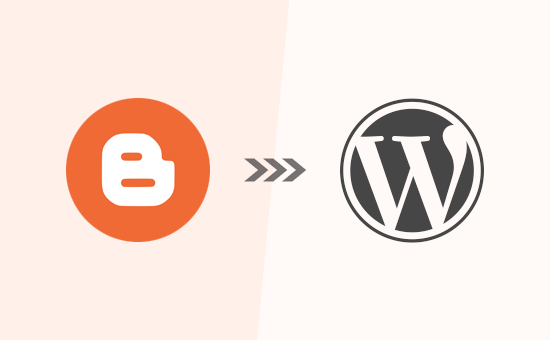
Warum von Blogger zu WordPress wechseln?
Blogger ist eine beliebte Blogging-Plattform, die von Google entwickelt wurde. Hier kann jeder mit seinem Google-Konto ein kostenloses Blog erstellen.
Viele Anfänger stellen jedoch schnell fest, dass sie mit ihrem kostenlosen Blogger-Blog nur sehr eingeschränkt arbeiten können.
Mit WordPress hingegen haben Sie die volle Kontrolle über Ihre Website. Außerdem können Sie die notwendigen Funktionen hinzufügen, um Ihren Blog zu erweitern und Ihre Inhalte zu vermarkten. Außerdem können Sie alle SEO-Optimierungen durchführen, um eine bessere Platzierung zu erreichen. Wir haben eine detaillierte Gegenüberstellung von WordPress und Blogger erstellt.
Wenn wir von WordPress sprechen, meinen wir das selbst gehostete WordPress.org, das NICHT mit WordPress.com verwechselt werden sollte, einer gehosteten Lösung, die ihre eigenen Einschränkungen hat. Einzelheiten finden Sie in unserem Artikel über den Unterschied zwischen WordPress.com und WordPress.org.
WordPress.org ist die beliebte „WordPress“-Plattform, von der Sie wahrscheinlich schon gehört haben, weil sie 43 % aller Websites im Internet betreibt.
Schauen wir uns also an, wie man richtig von Blogger zu WordPress wechselt und dabei die Google-Suchergebnisse und den Website-Traffic beibehält.
Hier sind die Schritte, die wir verwenden werden, um von Blogger zu WordPress zu übertragen:
Sind Sie bereit? Dann fangen wir an.
Video-Anleitung
Wenn Sie sich das Video-Tutorial nicht ansehen möchten, können Sie die Textversion weiter unten lesen.
Schritt 1: Registrieren Sie sich für WordPress Hosts
Um mit WordPress zu beginnen, benötigen Sie einen Domainnamen und ein Webhosting.
Zur Erinnerung: Ein Domain-Name ist die Adresse Ihrer Website, die man eintippt, um zu Ihrem Blog zu gelangen, und das Webhosting ist der Ort, an dem die Dateien Ihrer Website gespeichert sind. Beides ist ein MUSS für jede Art von Blog oder Website.
Wir empfehlen daher Bluehost. Bluehost ist eines der größten Hosting-Unternehmen der Welt und ein offiziell empfohlener WordPress-Hosting-Partner.
Da WPBeginner die größte Website für WordPress Ressourcen ist, haben sie zugestimmt, unseren Besuchern einen kostenlosen Domainnamen und einen 60%igen Rabatt auf das Hosting anzubieten. Im Grunde können Sie für nur 1,99 $ pro Monat loslegen.
Wenn Sie aus irgendeinem Grund eine Bluehost-Alternative bevorzugen, dann empfehlen wir Ihnen entweder SiteGround oder Hostinger, da beide ausgezeichnete Lösungen sind.
Sobald Sie sich für das WordPress-Hostingpaket angemeldet und Ihren Domainnamen eingerichtet haben, können Sie mit der WordPress-Installation fortfahren.
Wenn Sie sich bei Bluehost über unseren obigen Link anmelden, wird WordPress automatisch für Sie installiert.
Wenn Sie einen anderen WordPress-Hosting-Anbieter verwendet haben, müssen Sie WordPress installieren, indem Sie unsere ultimative Anleitung zur Installation von WordPress befolgen.
Nachdem Sie WordPress installiert haben, ist es an der Zeit, Ihre Inhalte von Blogger zu WordPress zu übertragen.
Kostenloses Bonusangebot: Da viele von Ihnen danach gefragt haben, bieten wir jetzt einen kostenlosen Migrationsdienst von Blogger zu WordPress als Teil unseres kostenlosen WordPress-Blog-Einrichtungsdienstes an. Das bedeutet, dass eines unserer fachkundigen Teammitglieder die gesamte Migration für Sie durchführt (100% kostenlos). Ja, Sie können buchstäblich ohne jedes Risiko von Blogger zu WordPress wechseln.
Hinweis: Unser kostenloser Blogger-Migrationsdienst ist für kleinere Blogs mit weniger als 1000 Blogbeiträgen gedacht. Wir können einen Migrationsdienst für größere Blogger-Websites anbieten, aber das ist ein kostenpflichtiger Dienst.
Wenn Sie jedoch jemand sind, der gerne lernt und Dinge selbst macht, dann können Sie unserer Schritt-für-Schritt-Anleitung unten folgen.
Schritt 1: Exportieren Sie Ihr Blogger-Blog
Als Erstes müssen Sie den Inhalt Ihres Blogger-Blogs exportieren.
Sie können dies tun, indem Sie die Blogger-Website besuchen und sich bei Ihrem Konto-Dashboard anmelden.
Gehen Sie dann zur Seite Einstellungen. Scrollen Sie nach unten zum Abschnitt „Blog verwalten“ und klicken Sie auf die Schaltfläche „Inhalt sichern“.
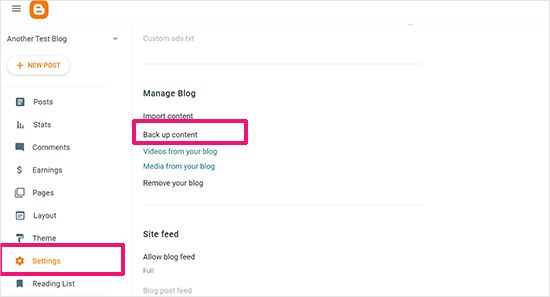
Daraufhin erscheint ein Popup-Fenster, in dem angezeigt wird, was genau in der Blogger-Sicherung enthalten ist.
Um fortzufahren, müssen Sie auf die Schaltfläche „Herunterladen“ klicken.
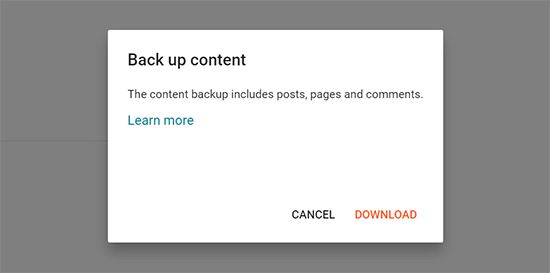
Der Inhalt Ihres Blogger-Blogs wird in einer XML-Datei auf Ihren Computer heruntergeladen.
Sobald der Download abgeschlossen ist, können Sie Ihre Blogger-Inhalte in Ihre WordPress-Website importieren.
Schritt 2: Blogger in WordPress importieren
Um mit dem Import Ihrer Blogger-Site in WordPress zu beginnen, melden Sie sich in Ihrem WordPress-Administrationsbereich an und besuchen Sie Tools “ Importieren.
Klicken Sie auf der Import-Seite auf den Link „Jetzt installieren“ unter Blogger.
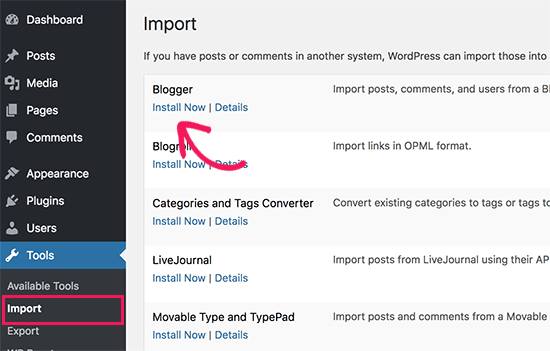
WordPress wird nun das Blogger-Importer-Plugin für Sie herunterladen und installieren.
Sobald die Installation abgeschlossen ist, müssen Sie auf den Link „Importer ausführen“ klicken, um fortzufahren.
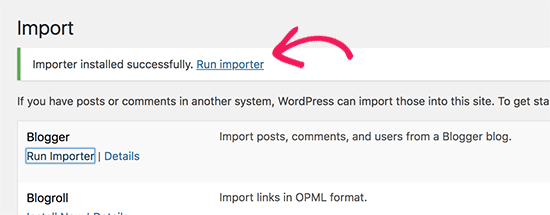
WordPress wird Sie auf dem Bildschirm Blogger importieren auffordern, die XML-Datei hochzuladen. Dies ist die Datei, die Sie in Schritt 1 heruntergeladen haben.
Klicken Sie einfach auf die Schaltfläche „Datei auswählen“ und laden Sie die XML-Datei hoch, die Sie zuvor heruntergeladen haben.
Klicken Sie anschließend auf die Schaltfläche „Datei hochladen und importieren“, um fortzufahren.
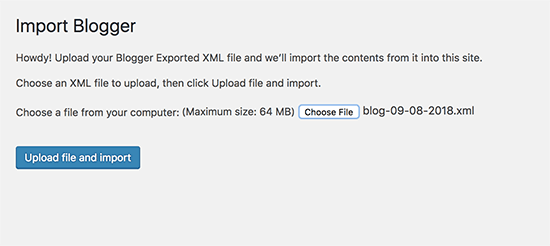
WordPress wird nun die Importdatei hochladen. Wenn Ihre Importdatei zu groß ist, wird möglicherweise eine Fehlermeldung angezeigt.
In diesem Fall müssen Sie die Höchstgrenze für den Datei-Upload erhöhen. Wenn Ihre Datei klein ist, werden Sie keine Fehler sehen.
Als Nächstes werden Sie aufgefordert, Beiträge einem Autor zuzuweisen. Wenn Sie mehrere Autoren in Ihrem Blogger-Blog haben, können Sie für jeden Autor ein neues Benutzerkonto erstellen. Sie können diese Beiträge auch bestehenden Autoren auf Ihrer WordPress-Website zuweisen.
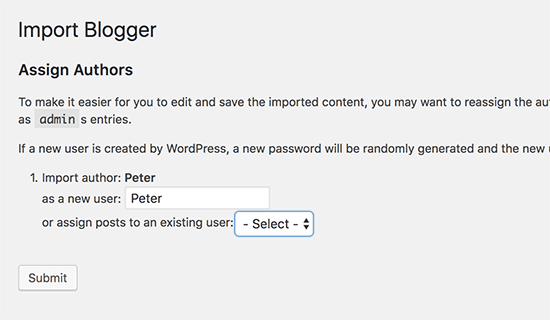
Nachdem Sie Ihre Auswahl getroffen haben, klicken Sie auf die Schaltfläche „Senden“, um fortzufahren.
WordPress importiert alle Inhalte aus der Blogger-Exportdatei in Ihre WordPress-Website. Sie können den Inhalt auf der Seite Beiträge “ Alle Beiträge einsehen.
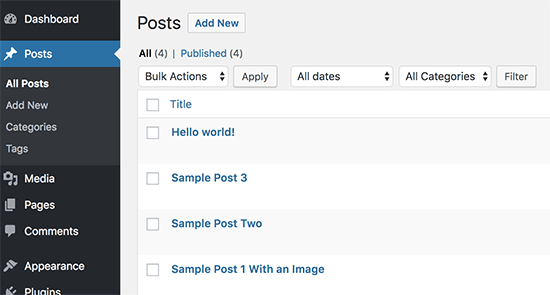
Schritt 3: Permalinks einrichten
Permalinks ist der Begriff für die URL-Struktur der einzelnen Seiten. WordPress verfügt über eine Funktion, mit der Sie eine SEO-freundliche URL-Struktur einrichten können.
Da Sie Inhalte von Blogger importieren, muss Ihre URL-Struktur der URL-Struktur Ihrer alten Blogger-Site so nahe wie möglich kommen.
Um Permalinks zu setzen, müssen Sie in Ihrem WordPress-Dashboard zu Einstellungen “ Permalinks gehen und die Option „Benutzerdefinierte Struktur“ wählen.
Danach müssen Sie den folgenden Text in das Feld neben dem Feld für die benutzerdefinierte Struktur eingeben:
1 | /%year%/%monthnum%/%postname%.html |
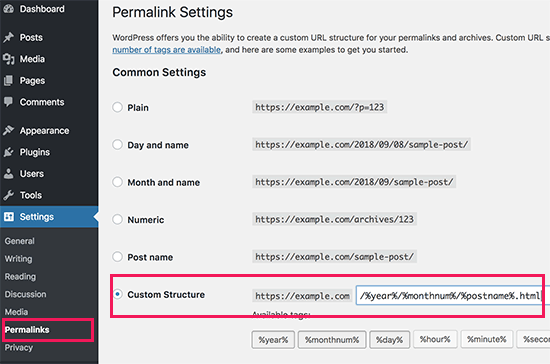
Mit dieser Permalink-Struktur ähneln die URLs Ihrer Blogposts den URLs in Ihrem alten Blogger-Blog.
Es kann jedoch vorkommen, dass die URL Ihres Blogeintrags, in WordPress auch als Slug bezeichnet, nicht mit den von Blogger verwendeten Slugs übereinstimmt.
Um dies zu beheben, müssen Sie ein kleines Codeschnipsel erstellen und ausführen.
Wir empfehlen, diesen PHP-Code mit dem WPCode-Plugin hinzuzufügen. Das ist der sicherste Weg, um benutzerdefinierten Code zu Ihrer WordPress-Website hinzuzufügen. Weitere Einzelheiten finden Sie in unserer Anleitung zum Kopieren und Einfügen von Codefragmenten in WordPress.
1 2 3 4 5 6 7 8 9 10 11 12 13 14 | add_action( 'init', 'wpb_update_slug' );function wpb_update_slug() {global $wpdb;$result = $wpdb->get_results("SELECT post_id, meta_value FROM $wpdb->postmeta WHERE meta_key = 'blogger_permalink' ");$wpdb->print_error();foreach ($result as $row){$slug = explode("/",$row->meta_value);$slug = explode(".",$slug[3]);$wpdb->query("UPDATE $wpdb->posts SET post_name ='$slug[0]' WHERE ID = '$row->post_id' ");}echo "DONE";} |
Nachdem Sie den Code gespeichert haben, brauchen Sie nur eine beliebige Seite auf Ihrer WordPress-Website zu besuchen, um dieses Skript auszulösen.
Wichtig: Vergessen Sie nicht, das Skript nach seiner Ausführung zu deaktivieren oder aus Ihrer WPCode-Bibliothek zu löschen, da es nur einmal ausgeführt werden muss.
Kostenloses Bonusangebot: Sie wollen sich nicht mit Codes herumschlagen? Wir haben ein Angebot für Sie. Da viele von Ihnen danach gefragt haben, bieten wir jetzt einen kostenlosen Migrationsdienst von Blogger zu WordPress als Teil unseres kostenlosen WordPress-Blog-Einrichtungsdienstes an.
Das bedeutet, dass einer unserer Experten die gesamte Migration für Sie übernimmt (100% kostenlos). Ja, Sie können buchstäblich ohne jedes Risiko von Blogger zu WordPress wechseln.
Schritt 4: Umleitungen von Blogger zu WordPress einrichten
Der wichtigste Schritt beim Umzug einer Website ist die Einrichtung einer korrekten Umleitung, damit Sie keinen bestehenden Traffic oder SEO-Rankings verlieren. Weitere Details finden Sie in unserer ultimativen WordPress SEO-Migrations-Checkliste.
Hinweis: Wenn Ihr Blogger-Blog eine eigene benutzerdefinierte Domain anstelle von blogspot.com hat, müssen Sie möglicherweise die Nameserver Ihrer Domain auf Ihren Hosting-Provider verweisen. Anweisungen dazu finden Sie in unserer Anleitung zum Wechsel von Blogger-Blogs mit eigener Domain zu WordPress.
Entscheidend bei der Weiterleitung ist, dass Ihre Nutzer auf der neuen Domain auf der gleichen Seite landen, die sie auf der alten Site aufgerufen haben.
Gleichzeitig müssen Sie dafür sorgen, dass die Suchmaschinen verstehen, dass Ihre Website an diesen neuen Ort verlegt wurde.
Dazu müssen Sie das Plugin für die Umleitung von Blogger zu WordPress installieren und aktivieren. Weitere Details finden Sie in unserer Schritt-für-Schritt-Anleitung zur Installation eines WordPress-Plugins.
Nach der Aktivierung müssen Sie die Seite Tools “ Blogger to WordPress Redirection besuchen und auf die Schaltfläche „Start Configuration“ klicken.
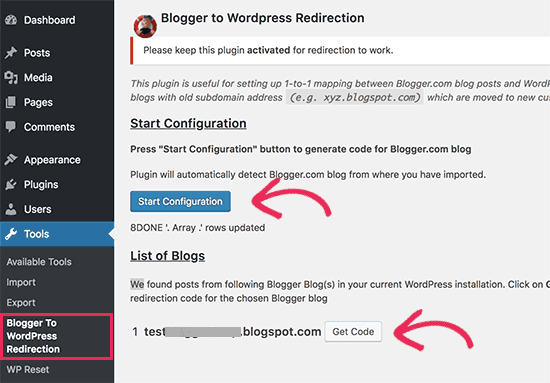
Das Plugin erkennt nun die URL Ihres Blogger-Blogs und zeigt Ihnen die Option an, einen Umleitungscode zu erhalten. Klicken Sie auf die Schaltfläche „Code abrufen“ neben Ihrer Blogger-URL.
Es wird nun ein Codeschnipsel generiert, den Sie benötigen, um Benutzer von Ihrem alten Blogger-Blog auf Ihre neue WordPress-Website umzuleiten.
Als Nächstes müssen Sie sich in Ihrem Blogger-Dashboard anmelden und die Seite „Themen“ aufrufen. Klicken Sie auf den Dropdown-Pfeil auf der Schaltfläche „Anpassen“ neben Ihrem Thema, und wählen Sie dann die Option „HTML bearbeiten“.
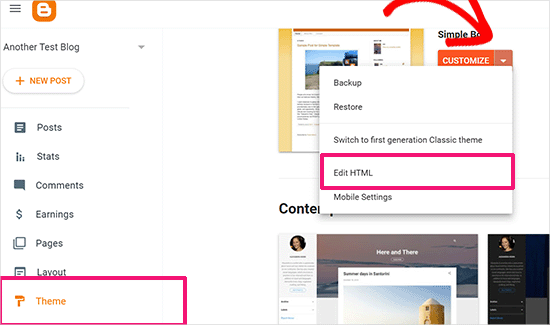
Blogger zeigt nun den benutzerdefinierten HTML-Code für Ihre Themenvorlage an. Wenn Sie Anpassungen an Ihrem Blogger-Theme vorgenommen haben, sollten Sie den Code kopieren und auf Ihrem Computer als Backup speichern.
Andernfalls können Sie einfach alles löschen. Kopieren Sie anschließend den vom Plugin angezeigten Code auf Ihrer WordPress-Website und fügen Sie ihn in den Editor Ihres Blogger-Themas ein.
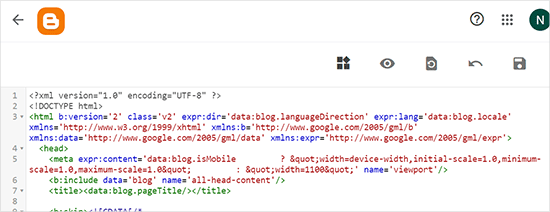
Vergessen Sie nicht, auf die Schaltfläche „Thema speichern“ zu klicken, um Ihre Änderungen zu speichern.
Als Nächstes müssen wir Umleitungen für mobile Benutzer einrichten.
Gehen Sie im Dashboard Ihres Blogger-Blogs zurück zur Seite „Themen“. Diesmal müssen Sie auf die Zahnrad-Schaltfläche unterhalb der mobilen Vorschau Ihres Blogs klicken.
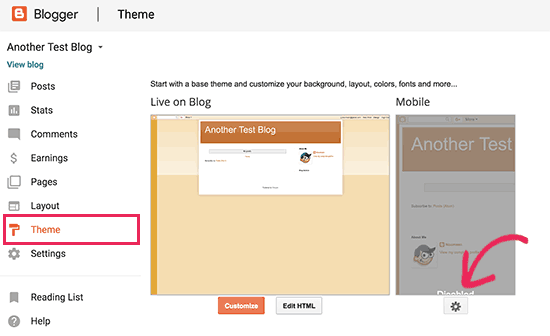
Daraufhin wird ein Popup-Fenster angezeigt, in dem Sie die Option „Nein. Desktop-Thema auf mobilen Geräten anzeigen“ auswählen müssen.
Klicken Sie dann auf die Schaltfläche „Speichern“.
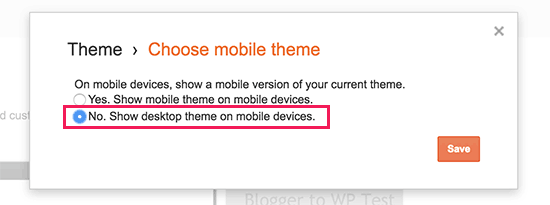
Das war’s. Ihr Blogger-Blog leitet nun alle Besucher Ihres Blogs auf Ihr neues WordPress-Blog um.
Alternativ können Sie auch All in One SEO (AIOSEO) verwenden, um Beiträge und Seiten von Blogger zu WordPress umzuleiten. Das Plugin bietet eine leistungsstarke Funktion für den Weiterleitungsmanager, mit der Sie vollständige Weiterleitungen zu Ihrer neuen Website einrichten können.
Außerdem können Sie die Verfolgung von 404-Fehlern aktivieren und alle defekten Links aufspüren, die bei der Umstellung Ihrer Website auf WordPress auftreten können. Dadurch wird die Benutzerfreundlichkeit verbessert, und Sie verlieren keine Keyword-Rankings.
Schritt 5: Verschieben anderer Inhalte von Blogger zu WordPress
In diesem Schritt werden wir die restlichen Inhalte aus dem alten Blog auf Blogger in Ihren neuen WordPress-Blog verschieben. Dies kann je nach den Einstellungen/Inhalten Ihres Blogs etwas manuelle Arbeit erfordern.
1. Verschieben von Seiten von Blogger zu WordPress
Das Blogger-Import-Tool von WordPress importiert nur Blogger-Beiträge und ignoriert Seiten.
Um Ihre Seiten in WordPress zu übertragen, müssen Sie jede Seite in Ihrem Blogger-Blog bearbeiten, ihren Inhalt kopieren und dann manuell eine Seite in WordPress erstellen.
Um mehr über Seiten zu erfahren, lesen Sie unseren Artikel über den Unterschied zwischen Posts und Seiten in WordPress.
Nun werden Sie auf ein weiteres Problem stoßen. Die Blogger-Seiten haben URLs, die wie folgt aussehen:
http://example.blogspot.com/p/about-us.html
Die URL Ihrer WordPress-Seite sieht dann so aus:
http://example.com/about-us
Um dies zu beheben, müssen Sie das All in One SEO (AIOSEO) Plugin verwenden. Eine Anleitung dazu finden Sie in unserem Leitfaden für Einsteiger zum Erstellen von Weiterleitungen in WordPress.
2. Widgets
Wie Blogger verwenden auch einige WordPress-Themes Widgets, um Inhalte in die Seitenleiste Ihres Blogs einzufügen.
Um Widgets hinzuzufügen, müssen Sie die Seite Erscheinungsbild “ Widgets in Ihrem WordPress-Dashboard aufrufen und Widgets einfach per Drag & Drop in die Seitenleisten ziehen. Ausführliche Anweisungen finden Sie in unserem Leitfaden zum Hinzufügen und Verwenden von Widgets in WordPress.
Wenn Sie ein bestimmtes Widget suchen, das nicht standardmäßig in WordPress enthalten ist, dann benötigen Sie wahrscheinlich ein WordPress-Plugin. Sie können WPBeginners beste WordPress-Plugin-Kategorie durchsuchen, um die gewünschte Funktionalität zu finden.
3. RSS-Feeds
Suchmaschinen und Nutzer, die Ihre Blog-Beiträge über RSS-Feeds abonnieren, können Ihr Blog weiterhin finden. Sie werden jedoch keine neuen Inhalte erhalten.
Um dies zu beheben, besuchen Sie die Seite Einstellungen in Ihrem Blogger-Konto. Scrollen Sie dann nach unten zum Abschnitt „Site-Feed“ und klicken Sie auf „Post-Feed-Redirect-URL“.
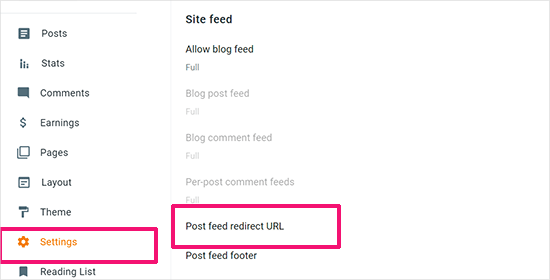
Daraufhin wird ein Popup-Fenster angezeigt, in das Sie die URL des RSS-Feeds Ihrer WordPress-Website eingeben müssen.
Die URL Ihres WordPress-Feeds sieht dann so aus:
http://example.com/feed
Vergessen Sie nicht, example.com durch Ihren eigenen Domänennamen zu ersetzen.
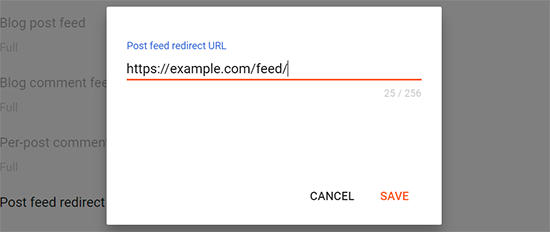
Klicken Sie auf die Schaltfläche „Speichern“, um die URL hinzuzufügen und Ihre Einstellungen zu speichern.
Schritt 6. Was Sie nach der Migration von Blogger zu WordPress tun sollten
Nachdem Sie Ihren Blogger-Blog nun erfolgreich nach WordPress verschoben haben, wollen wir uns ansehen, was Sie noch tun können, um Ihren Blog zu verbessern.
Wir haben eine Checkliste mit den wichtigsten Dingen erstellt, die Sie nach der Installation von WordPress erledigen müssen.
WordPress ist recht einfach zu bedienen. Dennoch werden Sie gelegentlich neue Dinge entdecken, bei denen Sie vielleicht Hilfe benötigen. An dieser Stelle kommt WPBeginner ins Spiel.
WPBeginner ist die größte kostenlose WordPress-Ressourcen-Website der Welt. Wir veröffentlichen regelmäßig Tutorials und Anleitungen, die speziell für Blogger und kleine Unternehmen geschrieben wurden.
Hier sind einige der nützlichen Ressourcen, die Sie auf WPBeginner finden werden (alle sind kostenlos):
- WPBeginner Blog – Der zentrale Ort für alle unsere WordPress-Tutorials und -Anleitungen.
- WPBeginner Dictionary – Unser WordPress-Glossar ist der beste Ort, um sich mit dem WordPress-Jargon vertraut zu machen
- WPBeginner Videos – Neue WordPress-Nutzer können mit diesen Schritt-für-Schritt-Videos beginnen, WordPress zu beherrschen.
- WPBeginner auf YouTube – Brauchen Sie mehr Videoanleitungen? Abonnieren Sie unseren YouTube-Kanal mit mehr als 291.000 Abonnenten und über 50 Millionen Aufrufen.
- WPBeginner Blueprint – Sehen Sie sich die Plugins, Tools und Dienstleistungen an, die wir auf WPBeginner verwenden.
- WPBeginner Deals – Exklusive Rabatte auf WordPress Produkte und Dienstleistungen für WPBeginner Nutzer.
Wir hoffen, dass dieser Artikel Ihnen geholfen hat, von Blogger zu WordPress zu wechseln, ohne Ihre Google-Suchergebnisse zu beeinträchtigen. Vielleicht interessiert Sie auch unser Leitfaden, welchen WordPress-Plan Sie verwenden sollten, oder die häufigsten WordPress-Mythen, die entlarvt wurden.
Wenn Ihnen dieser Artikel gefallen hat, dann abonnieren Sie bitte unseren YouTube-Kanal für WordPress-Videotutorials. Sie können uns auch auf Twitter und Facebook finden.

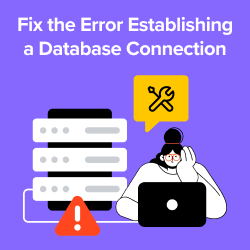



Niveditha
Hi, I could successfully migrate from blogger to wordpress. But there seems to be a problem with RSS feed. The subscription mail of the new posts are not coming. How can I solve this problem. Pls help!
shailesh shakya
This post i very helpful for me thanks ……..
Nicole
Thank you for these instrucionts-I have finished with step 4-the first step. I added your code and the visitors are redirected to my new website. But it takes a while until the page is loading and there are displayed some numbers. 01 02 03 04 05 on the screen. It looks not so nice—could it be replaced-or how to make it faster?
I also dont know how to do the last step with the php-code. My enfold theme has a functions-php and a functions-enfold.php. I already tried the code at the end of the functions.php-with no effect. I deleted it again.
Could you give me a hint what to search for or to test?
Thank you in advance
Nicole
Nicole
I have solved my problem. with another tool. Tank you! Nicole
Tank you! Nicole
Dipankar
Thank you so much! migration is successful .
now please tell me what to do with sitemap of old blogger as well as wordpress?
Gurunath
Hi, I have done the process of Blogger to WP migration step by step and I did get migration successfully. But the problem is I have done all the plugins and theme customization and while doing configuration of Yoast SEO Plugin and exactly when I was adding the google webmaster tools verification and when pressed the save button it said „can’t verify site“ and the site is down. now when I am entering the URL from the blog spot or direct url..it is asking for install WordPress thing …how to solve this? please help it out
Mahesh suthar
I have migrated from blogger to wordpress, i was having custom domain, but after migration my older links with custom domain are not redirecting to the newer link generated in wordpress. I have changed the permalink as per your article. Please help me.
Ömür Yanıkoğlu
Thanks to you, I have solved my problem. This is very useful article
Timmy Brain
I’d followed the guide duly but the import blogger plugin gives me an error note of some lines are missing.
Abigail
I have tried EVERYTHING I can to try to redirect my blogger to wordpress site. I have input the code you have on here multiple MULTIPLE times, and I can’t for the life of me get it to work. The worst part is, now my old blogger blog is GONE and now my readers aren’t going to know what is going on. If you could please email me I would really appreciate it.
WPBeginner Support
Hi Abigail,
If you followed the instructions, then your old Blogger blog isn’t gone. It is still there and you can switch back to it. Simply login to your blogger dashboard, go to Templates. Click on the Upgrade Template button and then select a new template for your blogger blog. Your Blogger blog will now become visible again.
However, we believe that you probably still want to move to WordPress. We will advice you not to give up, there is probably some tiny thing that you are missing. Follow the steps carefully again, and you will be able to properly redirect your readers to your new WordPress site.
Good luck
Admin
Samuel
My website is not opening after i updated it. Hello please i need help on this; i login to my wp-admin dashboard and see a notification message from wordpress that i’m using an whole version of wordpress that i should upgrade to the latest version. I follow the instruction to updates my wordpress sites but after a successful update my webpages are not opening again. It will just be loading and reloading without anything displaying. And why it is loading it will be displaying a blink of blogger icon.
Satish Kushwaha
Still unable to resolve 404 error not found
Sheetal
Hello, Satish Kindly contact your web hoster. Even I used to get this error and bluhost resolved it.
LIz
I was fine until I went to settings and there is not migrate blog only delete and back up? What now?
WPBeginner Support
@Liz: You need to click on the Back up Content button. We have updated the article, with new screenshots. Instead of export, the feature is now called Backup.
Admin
Mike Gil
Howdy.
First thanks for this tutorial, Im done migrating my site from blogger to wordpress. The problem is when I search my posts on google and click a link from blogger, it will redirect me to wordpress with .html on the link so it gibes error 404. I hope you can help me.
Thank you.
Mahesh suthar
Have you solved your problem? If yes then can u please help me
Gagan kamboj
I have imported all the blogspot content to wp ….. Now should i delete the blogger blog??
Paloma
She mentioned that you have to keep your blogger running. So don’t delete your blogger blog.
Andrew
Hey, I got everything over and redirected just fine. Thanks for the great videos!
But, I realize I need to get more info off the blogspot site. I am being redirected even from withing the blogger console. How do I access my blogger site now that the redirects are up?
Thanks!
md qureshi
after transfer my blogger blog to wordpress in the google search when i click on post a 404 page not found show how can I fix them?
Sheetal
For this error you need to contact your web hosters !
Navdeep
I have a custom domain name setup on my blogger blog. Do I have to first remove it from my blog to follow the above steps? Please help.
WPBeginner Support
Yes, you will first have to remove it.
Admin
Rajesh
I had successfully imported my blogger.com blog into my wordpress website. it was very helpful thanks for this wonderful help. Now if i post a new blog at blogger .com then will it automatically feed into website. or should i posts on my website only. i posted a new post on blogger.com but that post didn’t feed in website. please guide me. thank you.
WPBeginner Support
You need to post on your new WordPress powered website.
Admin
Tonya Wilhelm
Thank, you. I’m going to try…a bit scared! This won’t be considered duplicate content, will it? It will disappear from blogger and move to wordpress?
WPBeginner Support
Yes, your Blogger content will no longer be visible to search engines as they will be redirected to your WordPress site.
Admin
Nixy
Hi,
Thanks for your wonderful tutorial.
I have migrated my blogger blog to WordPress. But I have 2 specific problem. Can you please help?
1) If I search my blog from a mobile device, and click the link, redirect doesn’t happen.
2) I have 2 pages on my blogger blog. Say About and Contact, but the redirection doesn’t happen for them.
Your help will be highly appreciated.
With thanks,
Nixy
John
If the mobile redirect does not work, try to disable the mobile template first (before reverting to the classic template in step 4). This should prevent blogger from adding „?m=1“ to the URL, which is why the redirect from mobile doesn’t happen. Hope that helps!
Jamal
Hello! Thanks for the post, very helpful.
One thing though. On Redirect Checker it says that my redirect is a 303 one
WPBeginner Support
Try some other tool as well. If you are on a Mac you can use this command in terminal
curl -I http://example.com
Replace example.com with your own domain name.
Admin
Sagar Nangare
Hi
I want to redirect to http://www.example.com/articles/ from my old blog URLs. I tried your steps but it did not help. It is redirecting to main home URL. that is http://www.example.com. Please help with this one
Beini
Trying to do this but I don’t seem to have a permalink settings tab under settings!
WPBeginner Support
Are you sure that you are using self hosted WordPress? Please see our guide on the difference between self hosted WordPress.org vs free WordPress.com blog.
Admin
Cat Larkin
When editing your functions.php file – will those edits hold when you update your theme or when you do WordPress updates, or do you have to do this each time you update? Or do I need to be working with a child theme?
Also – If I plan to change themes, should I do that before I make the change to the functions.php – thus only doing it once?
Great tutorial – thanks
WPBeginner Support
Your theme’s functions.php file will get overwritten when you update the theme. To deal with this you can create a child theme and add custom code to child theme’s functions.php file. However, if you switch themes then you will have to copy paste the code.
Another approach is to use a site-specific plugin. It remains out of your theme and does not get’s in the way when you update any WordPress core, plugin, or theme files.
Admin
Ransom
To My Google Blog I Don’t See Export Or Import I Only See Import And Backup,
Lemonberry
I also don’t see an export button, only an Import button and a Back up Content button and was wondering if there is something I’m missing…?
Ali Asghar
Hey, currently my blog is and I want to shift it to

1) Is it possible?
2) Will the total views would show too or we would have to start from 0?
Kindly please reply to my question
Great post and great video!
WPBeginner Support
Yes it is possible, please see our guide on the difference between self hosted WordPress.org vs free WordPress.com blog.
Admin
aravind
I have a question. After blogger to wordpress migration and redirection, What to do with blogger posts? I can delete them?
karamath
I was thinking to hire some one to migrate my blog but now iam capable of migrating myself.
I will also post my experience of migration process. Really helpful post.
Thanks.
Lucy Edwards
Thanks for this- I’ve taken all the steps but the redirect doesn’t seem to be working properly for me. It works on a desktop computer, but from mobile devices the link still take you to my old blog. Any ideas what has gone wrong?
justice ozuruigbo
If i import my blogger posts to wordpress, will it still bear the original dates?
WPBeginner Support
Yes
Admin
Jamie
Thankyou! Painless and concise. My kinda tutorial
Sheetal
Thanks for this article. I have successfully migrated my blogspot blog to wordpress. I just wanted to know that should I deactivate blogger importer plugin or not ? Thanks
WPBeginner Support
Yes, you can deactivate it.
Admin
Sheetal
Thank you so much It is really helpful
It is really helpful 
JP Mishra
Can we export blog to drupal or joomla?
Gail
Thank you a million times over! I really am new to all this, but your step by step tutorial on how to switch to WP worked for me the very first time! My redirects and everything (at least that I’ve checked so far) are working great! Thank you again, you made this so much easier than what I expected!
WPBeginner Support
Glad you found it helpful.
Admin
Jen
Thank you so much for the awesome tutorial! It was easy to follow. But I only have one problem. Some of my pictures didn’t transfer and I did Step 6. I think it may be because those pictures were from my Google Drive. Is there a way to transfer them or would I manually have to upload those images again? Thanks for your help.
Paige
Love this site so much! So question is when I copy and paste the lines get all jumbled when I try to paste it into my php thingy. I deleted it because I was scared I would blow something up on my site. Is there a way to make my paste look like what I copied?
WPBeginner Support
Take your mouse over to code snippet on our site and you will see a viewsource button at the top right corner of the snippet. Clicking on it will open the source code in new popup window. Copy that code and then paste it.
Admin
Rena
PLEASE HELP! I did everything your post and video says but for some reason when I click on an old link for a specific post, it redirects to the .com but to the homepage, not the actual post.
How can I fix this?
For example, which I click on this-
it brings me to this-
THANK YOU!!!
satz
make sure the destination of your wordpress post slug are the same with your old blogger post slug. for example if your blogpost url are example.blogspot.com/2016/05/your-post-slug.html then make sure your wordpress url are example.com/2016/05/your-post-slug/
Bharat
window.location.href=“http://example.com/?blogger=“
These lines of code are giving an error in blogger.
Error parsing XML, line 3, column 11: The content of elements must consist of well-formed character data or markup.
Christopher
I’m having issues on the 301 redirection. I’m Using News pro genesis child theme, should i paste the code in the function.php of the child theme or function.php of Genesis frame work?
Barry O'Leary
Thanks so much have managed to migrate a blog of over 200 posts to a new one and not lost anything. Great stuff! Thanks.
WPBeginner Support
Glad you found it helpful.
Admin
Heike
Thank you for this tutorial! Everything moved over fine, except the pictures. Can you advise?
WPBeginner Support
Looks like you already resolved the issue
Admin
Heike
Yes, I uploaded another plug in that transfered the photos too. Unfortunately, now all posts are double, with the same publishing date. This means I get to go back and reminisce while I delete doubles! Still, I appreciate the tutorial, it really helps to have both the video and written instructions. Also, why do I have to go into the FTP for each template? You mentioned if I change templates, to do this again?
emily
What was the plugin for importing media from blogger? I am having this problem too.
Dinesh
hey Heike
which plugin you use to Import photos and videos?
Jess
Yes, which plugin was this?
Susan
Hi there. I’m really frustrated. I posted a comment on Apr. 6 but haven’t heard back from anyone.
I followed the instructions on how to switch from blogger to wordpress. And I made a site-specific plugin because I was nervous about messing with the functions.php code to put in that redirect code.
Here’s the problem: with that site-specific plugin activated on my website (susansinthegarden.com), if I click on a link to a blog post that was on my old blogger site, it redirects to my new homepage… which is great, but my goal is to have a person go directly to the SAME post on my new website and not to my homepage.
What am I doing wrong? I’m losing sleep over this so please help ASAP! (and if anyone else sees this and knows what’s wrong, please comment. I’d really appreciate it!) Thanks.
Christopher
I’m also having the same issues. Have you been able to solve yours? If yes, How?
Susan
Hi, Christopher. I’ve heard from anyone about this. Have no idea how to solve this problem as I’ve done everything to the letter. Very frustrating. I wish someone would help us out with this problem. Sooo, if anyone out there experienced this, would you please let us know how you solved it so folks are directed from an old Blogger post to the SAME post on WordPress? Thank you.
Susan
Sorry, meant to say „I haven’t heard from anyone about this.“
Christopher
Hello, Susan. Hope you are good?
I was able to redirect mine but I had to purchase Yoast SEO premium . Yoast did all the redirection for me.
Kadi
I don’t have the blog tools or export in blogger. Mine just says delete blog.????
Kris
I’m having the same problem Kadi is having – blogger doesn’t give me the „import/export“ option, just „delete blog“. Would love to hear how to export from blogger to WP or it’ll be a lot of cut & pasting. Thanks!
Thanks!
Christopher
Above „Delete Blog“ you should see ‚Import Content‘ and „Backup content“. Just click on Backup content. Hope it works for you.
balu
Hello! Editorial Staff.
I have a problem.
I recently migrated from blogger to wordpress as you said in this tutorial. And also done changes in blogger template and in feed redirection. But posts are not redirecting from search results and also in post internal links.
What is the problem. I have also blogger custom domain. What to do?
Susan
I have a question re: setting up the permalinks. On blogger, this is the format of the links to my blog posts:
domain/yyyy_mm_01_postname.html
On WordPress, this is the format of the links to my blog posts:
domain/yyyy/mm/postname
So the differences are the underscores on blogger, plus the day, plus the „.html“ on the end.
How would I resolve this? Do search engines automatically „translate“ the underscores into slashes? And do they ignore the „.html“?
If this is the case, perhaps I would need to make a custom permalink that is something like this:
/%year%/%monthnum%/%daynum%/%postname%/
Could this work? Thanks in advance for your help.
Adam G
Thanks for the info– however, my blog is currently on blogger as its own domain name. How do I do the redirection if I’m going to switch the name over to wordpress as well?
My blog is currently I use blogger, but want to switch to wordpress, but continue to use
Martyna
Any of you experiencing 403 error after all of this. Contacted the domain hoster and said it probably the issue with the plugin that being used. Anyone else experienced that?
SMLocke
Thank you so much for this post, it is just what i was looking for. However, I am having an issue withe the 301 redirects. When a page is redirected, it is looking for domain.com/path/post-title.html whereas the permalinks in wordpress are domain.com/path/post-title/. That is, to be more succint, the URI ends with a ‚/‘ instead of ‚.html‘. Is there a way to remedy this.
Susan
Hi, SMLOCKE. Did you get a response on this because I’m having the same problem with the lack of an .html causing a 404 not found error. Thanks.
Kareem
Use the following customized permalink:
/%year%/%monthnum%/%postname%.html
It worked for me.
Thanks.
Stacy Ann
Can I say I love you to a stranger? Thank you so much! That custom link did the trick! I even called my hosting support and they couldn’t! You are awesome!!!!!!
Archna
Hi,
I’ve done everything explained above but stuck in the wordpress 301 redirection process
Error:
Parse error: syntax error, unexpected ‚<' in /home/manage1991/public_html/wp-content/themes/aqueduct/functions.php on line 446
/*————————————————————-
Redirection Code for Posts
—————————————–*/
<?php ////Line 446
function blogger_query_vars_filter( $vars ) {
$vars[] = "blogger";
return $vars;
}
.
.
.
WPBeginner Support
Please see our guide one how to fix syntax error in WordPress
Admin
thebdxoul
This is best wordpress blog ever